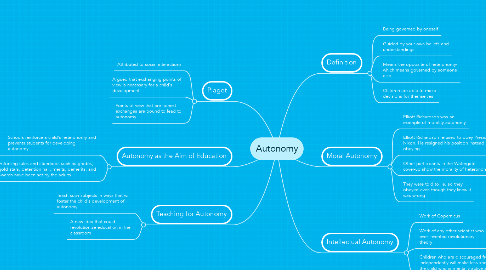Autonomy
by Amanda Smith

1. Piaget
1.1. Attributed to social interactions
1.2. Argued that exchanging points of view is necessary for a child's development
1.3. Points of view that are honest exchanges are bound to lead to autonomy
2. Autonomy as the Aim of Education
2.1. Schools reinforce a child's heteronomy and prevents students for developing autonomy
2.1.1. Project specifications
2.1.2. End User requirements
2.1.3. Action points sign-off
2.2. Enforcing rules and standards such as grades, gold stars, detention hall, merits, demerits, and awards have been set by the adults
2.2.1. Define actions as necessary
3. Teaching for Autonomy
3.1. Teach such subjects in ways that will foster the child's development of autonomy
3.2. A new idea that could revolutionize education in the classroom
4. Definition
4.1. Being governed by oneself
4.2. Guided by your own beliefs and understandings
4.3. Means the opposite of heteronomy- which means governed by someone else
4.4. Children are able to make decisions for themselves
5. Moral Autonomy
5.1. Elliott Richardson was an example of morality autonomy
5.2. Elliott Richardson refused to obey President Nixon. He resigned his position instead of obeying.
5.3. Other participants in the Watergate cover-up show the morality of heteronomy
5.4. They were told to lie, so they obeyed even though they knew it was wrong
6. Intellectual Autonomy
6.1. Work of Copernicus
6.2. Work of any other scientist who ever invented revolutionary theory
6.3. Children who are discouraged from thinking independently will make less knowledge than the child who is mentally active and confident


